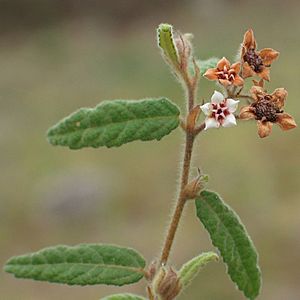Commersonia breviseta facts for kids
Quick facts for kids Commersonia breviseta |
|
|---|---|
 |
|
| Near Lochiel | |
| Scientific classification | |
| Genus: |
Commersonia
|
| Species: |
breviseta
|
| Synonyms | |
|
List
|
|
Commersonia breviseta is a type of flowering plant found in eastern Australia. It is a small shrub that grows low to the ground or stands upright. This plant has leaves that are covered in tiny hairs and are paler underneath. Its flowers have five white parts that look like petals, with pink edges. They also have five smaller, pale yellow petals and dark red parts called stamens.
About the Plant
Commersonia breviseta is a shrub that usually grows between 1 and 3 meters tall. Its branches are covered in fine hairs.
Leaves
When the plant is young, its leaves have three lobes. They are about 4.5 to 11 centimeters long and 2 to 4.5 centimeters wide. As the plant gets older, the leaves become more oval or egg-shaped. These adult leaves are smaller, about 0.8 to 2.4 centimeters long and 0.15 to 0.75 centimeters wide. They grow on a hairy stalk called a petiole, which is 0.1 to 0.6 centimeters long. The leaves are covered with white, star-shaped hairs. The underside of the leaves is lighter in color.
Flowers
The flowers grow in groups of two to sixteen. These groups are 0.8 to 3.5 centimeters long. Each group grows on a hairy stalk called a peduncle, which is 0.25 to 0.6 centimeters long. Individual flowers are on smaller hairy stalks called pedicels, about 0.2 to 0.65 centimeters long.
Each flower has five white parts that look like petals, called sepals. They have a green base and pink edges, and are about 0.35 to 0.65 centimeters long. There are also five pale yellow, cup-shaped petals, about 0.25 to 0.35 centimeters long. These petals have a white tip called a ligule, which is 0.15 to 0.25 centimeters long and turns pink as it gets older. The flowers have dark red stamens and five white staminodes. These staminodes surround the central part of the flower, which is called the style.
Flowering and Fruit
Commersonia breviseta flowers from September to November. After flowering, it produces a brown fruit. This fruit is a dry capsule, about 0.25 to 0.35 centimeters long and 0.45 to 0.55 centimeters wide. It is covered with soft white hairs and short, brown bristles.
Plant Naming
The plant was officially named Commersonia breviseta in 2008. This was done by scientists Carolyn F. Wilkins and Lachlan Mackenzie Copeland. They published their findings in a science journal called Telopea. The second part of its name, breviseta, means "short bristles." This refers to the short bristles found on the plant's fruit.
Where It Grows
This commersonia plant likes to grow in rocky areas. You can find it in heathlands or woodlands. Its range stretches from Girraween National Park in south-eastern Queensland down to Genoa in far north-eastern Victoria. It is most commonly found on the tablelands of New South Wales.
Life Cycle
Commersonia breviseta plants usually die after a bushfire. However, many new seeds sprout and grow after a fire. The plants then tend to live for about five years before they start to get old and die off naturally.

